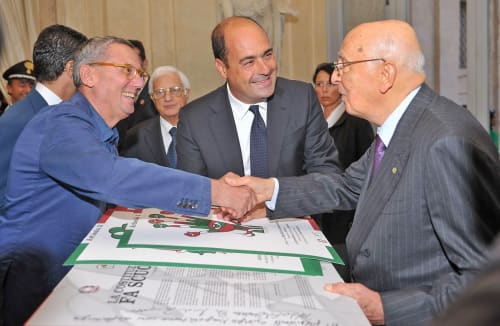«My city, Rome, is also the one where, during the Sixties, a generation raised on the rhythm of Beatles, Rolling Stones, Rokes and Equipe 84. Where the flower power was dialoguing with Bernini's flourishes […] Sacred and profane, ex-voto and advertising, classics icons and elettrics icons […] Contaminating forms which tends to roll up, to turn upside-down the surrounding environment. Agitandolo. Scuotendolo from the inside. Estroflettendo. Shake, Rattle and Roll»
Pablo Echaurren in Luca Massimo Barbero Conversazione con Pablo Echaurren, contenuto in Pablo Echaurren. Baroque 'n' Roll. Ceramiche, Macro - Museo di arte contemporanea Roma, edizione Gli Ori, Roma, 2011
Pablo Echaurren (Roma, 1951) is an Italian artist, music player and writer with a Chilean origin. His artistic life is fully immersed into sociability, into his daily existence. His works are linked to the comics world, the music, the street art and the mass culture, through this Pop iconography, combined with Dadaism and Surrealism languages, the artist presents his criticism of the society, using an ironic language both familiar and disturbing. Son of the Chilean painter Roberto Sebastian Matta, he starts to work as a painter too at the age of 18, and has been discovered by the critic and gallerist Arturo Shwarz: father of the Italian Dada-Surrealism and owner of a gallery in Milan, where Pablo will present his first solo show in 1974. His researches are initially focused on the creation of small paintings inspired by the comic-books style, like Starlight is sleeping (1974) and Buonasera, potete sentirmi? (1974), defined by the arist himself «not paintings, but pages of a conversation or an encyclopedic essay about myself and the world thet sorrounds me». In 1973 Enchaurren is invited by Achille Bonito Oliva to present his work at the show Contemporanea, at Villa Borghese in Rome; from this year the artist starts to gain an international recognition with several exhibitions in Europe and in the United States, including the one at the Paris Biennale in 1975.
His artistic language is original and dynamic, based on the Pop, minimal art and Poor Art experiences; it is also inspired by the world of Oyvind Fahlström and Gianfranco Baruchello, and by the work of the Japanese master Katsushika Hokusai, and so is visible in his brilliant ukiyo-e of nature and landscapes in Il fattore di Katsushika (1974). To these influences the artist adds a critical analysis on the globalization and the mass media phenomenon, and in 1977 he joins a movement called “Indiani metropolitani”, a young and ironic group, who was experimentating the Italian contro – cultura (anti-cultural movement), for whom Pablo designs magazine's covers, posters and anti-comics. From this period we recall the comics stories. Twenty years after on the life of the Futurism father Tommaso Marinetti, included in the catalogue Oltreconfine. Indiani metropolitani, maodadaisti e altri avventuristi a Roma (Rome, Joyce & co., 1988), and also the experimentations with pottery, tapestries, jewels and comics, before the artist returns to explore the true paint dimension. In 1997 he joints the Accademia di San Luca in Venezia, and presents at the Mostra Internazionale del Cinema di Venezia / Venice International Film Festival the movie Piccoli ergastoli, the result of a long activity done with some inmates at the Rebibbia prison in Rome. In 1999 the artist has been invited at the Venice Biennale.
From the beginning of the XXI century his work is focused on a series of canvases with a theme he defines Monstrum, where can be seen dreamy and macabre influences, mixed with popular culture, like in Gente fosforescente (2002). The great passion for music and for the elctric bass - Echaurren is a collector of this instrument and a big Ramones's supporter - become great creative stimulations for the colleges music-themed that will be exposed together with his musical instruments collectioned in two solo shows in Rome: L'invenzione del basso at the Music Auditorium (2009) and Baroque'n'Roll at the MACRO (2011) curated by Luca Massimo Barbero.
Many important exhibitions has been presented in Italians museums, such as: the Chiostro di Bramante (2004) and the Museo Fondazione Roma (2010-2011) in Rome, at the Magazzini del Sale di Cervia (2008), and at the MAR – Museo d'arte della città di Ravenna (2011).
Many exhibitions have been held at Galleria d'Arte Maggiore g.a.m. in Bologna among them Volo Solo, curated by Renato Barilli (2004) while the gallery has promoted Pablo Echaurren's work in many institutional show as Pablo Echaurren, lasciare il segno (1969-2011) at Mar - Museo d'Arte della città di Ravenna (2011); the important exhibition Matta: Roberto Sebastian Matta, Gordon Matta Clark, Pablo Echaurren, (catalogue Galleria d'Arte Maggiore g.a.m., Silvana Editoriale, 2013), curated by Danilo Eccher at Fondazione Querini Stampalia, during 55. Venice Biennale. In this show the work of Echaurren engages a dialogue with his father and his american brother showing the visionary creative language combined with the social aspect of their narrations thet they have in common. The year after Pablo exhibited in London with the solo show Iconoclast at the Estorick Collection of Modern Italian Art, and in 2015 at GNAM – Galleria Nazionale d'Arte Moderna with Pablo Echaurren. Contropittura in Rome. Last but not least the exhibition Du champ magnétique. Opere | Works 1977-2017 at Scala Contarini del Bovolo a Venezia and the collaboration for the Christmas lights dedicated to the song Futura by Lucio Dalla and realized by Associazione dei Commercianti di Via D'Azeglio, together with the Municipality of Bologna and Fondazione Lucio Dalla, to benifit Fondazione Policlinico Sant'Orsola , the hospital of Bologna (2020-2021).
